Published on October 4, 2023
The first RCT on vitamin D and cancer in 2007 showed 77% cancer prevention. That was sixteen years ago! If an intervention that costs about $10 a year can safely reduce the risk of cancer by one-third or more, why aren’t we doing anything about it now?
Key Points
- The featured video explains why many have been ‘stuck’ with moving vitamin D research into practice
- Results from a 2007, four year, population-based, double-blind, randomized, placebo-controlled trial found a 77% lower risk of cancer among participants taking vitamin D and calcium compared to placebo
- Follow-up studies on vitamin D and cancer prevention have found similar, positive results, including a 78-80% lower risk of breast cancer with vitamin D levels at or above 60 ng/ml (150 nmol/L)
In the video featured below, Keith Baggerly, PhD., MD Anderson Cancer Center, a “cancer researcher and a numbers geek,” discusses the math and science used to determine recommended vitamin D serum levels and supplementation amounts, and where the Institute of Medicine got it wrong.
This presentation was given at the American Public Health Association (APHA) Annual Meeting & Expo in November of 2016, the same conference at which Dr. Joan Lappe presented findings from her randomized controlled trials on vitamin D, calcium, and cancer risk. These results were published in several papers summarized below, including a 2016 paper showing more than 65% cancer prevention with vitamin D levels at or above 40 ng/ml (100 nmol/L).
Watch the Video
An intervention that costs about $10 a year can reduce the risk of cancer by one-third or more…? Why aren’t we doing anything about it now?! He explains in this video.
Video Summary
- Brief review of the current recommendations for vitamin D and how they were set
- The IOM set the target vitamin D level at 20 ng/ml (50 nmol/L); the Endocrine Society disagreed and set their target at 30 ng/ml (75 nmol/L)
- Review of the data used to assess bone health when determining the recommended serum levels, intake, and the mathematical mistakes made
- Fear from harm at the upper levels due to potential ‘J’ Curve and the “dread of danger overshadowing potential benefits”
- Where do we actually see toxicity from vitamin D? Explained…
It’s time! Dr. Lappe’s first study in 2007 showed over 65% cancer prevention at that time. That was sixteen years ago!
The First Randomized Controlled Trial on Vitamin D & Cancer
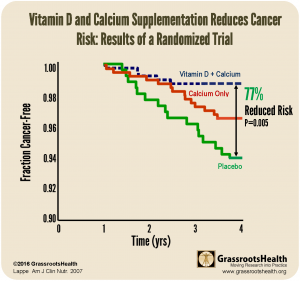 In 2007, Lappe et al. published Vitamin D and calcium supplementation reduces cancer risk: results of a randomized trial with results from a four year, population-based, double-blind, randomized, placebo-controlled trial, and data from 1179 healthy postmenopausal women, aged 55 or older. The primary outcome was the reduction of fractures, and the secondary outcome was cancer incidence. The population was white, lived around 41 degrees latitude, and had an average vitamin D level of 29 ng/ml (72 nmol/L). The treatment group took 1100 IU vitamin D and 1400-1500 mg calcium daily. A second group received calcium and a placebo for vitamin D and a third group that received only placebo – no active supplements at all.
In 2007, Lappe et al. published Vitamin D and calcium supplementation reduces cancer risk: results of a randomized trial with results from a four year, population-based, double-blind, randomized, placebo-controlled trial, and data from 1179 healthy postmenopausal women, aged 55 or older. The primary outcome was the reduction of fractures, and the secondary outcome was cancer incidence. The population was white, lived around 41 degrees latitude, and had an average vitamin D level of 29 ng/ml (72 nmol/L). The treatment group took 1100 IU vitamin D and 1400-1500 mg calcium daily. A second group received calcium and a placebo for vitamin D and a third group that received only placebo – no active supplements at all.
For those diagnosed with cancer after the first year, there was a 77% lower risk of cancer in the vitamin D and calcium group than placebo alone (P value <0.005). This group had an average vitamin D serum level of 38 ng/ml (96 nmol/L). This was the first intervention trial that showed that vitamin D can reduce cancer incidence. Unfortunately, since it was not the primary outcome many people in the research community discounted the cancer results of this study.
The First Randomized Controlled Trial Replicated, Published 2017
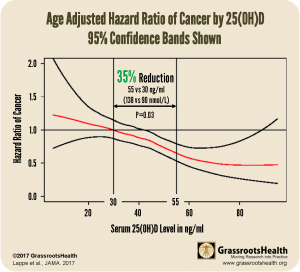 Lappe replicated her 2007 study with a larger population of 2303 women over a 4 year period using a larger vitamin D dose (2000 IU/day vs 1100 IU/day) with cancer incidence as the primary study endpoint. This new group started with an average vitamin D level of 33 ng/ml (82 nmol/L). Results were published as Effect of Vitamin D and Calcium Supplementation on Cancer Incidence in Older Women: A Randomized Clinical Trial in 2017.
Lappe replicated her 2007 study with a larger population of 2303 women over a 4 year period using a larger vitamin D dose (2000 IU/day vs 1100 IU/day) with cancer incidence as the primary study endpoint. This new group started with an average vitamin D level of 33 ng/ml (82 nmol/L). Results were published as Effect of Vitamin D and Calcium Supplementation on Cancer Incidence in Older Women: A Randomized Clinical Trial in 2017.
When analyzed by treatment group it showed a 30% reduction. When analyzed by serum level, the data showed that participants with a vitamin D level of 55 ng/ml were 35% less likely to get cancer as compared to those with a vitamin D level of 30 ng/ml (P value = 0.03).
Cancer Incidence by Vitamin D Serum Level in a Combined Cohort using D*action Participants
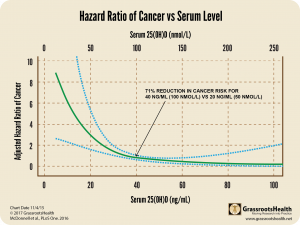 In April 2016, GrassrootsHealth partnered with leading vitamin D and cancer researchers Dr’s Garland, Gorham, Heaney and Lappe to publish Serum 25-Hydroxyvitamin D Concentrations ≥40 ng/ml Are Associated with >65% Lower Cancer Risk: Pooled Analysis of Randomized Trial and Prospective Cohort Study, a paper focused on achieved vitamin D serum levels and cancer incidence. Data was combined for women 55 and older from our GrassrootsHealth cohort (N = 1,135, median serum level = 48 ng/ml) and the cohort of a previously published randomized controlled trial (RCT) of vitamin D and calcium supplementation with respect to cancer (Lappe RCT paper; N= 1,169, median serum level = 30 ng/ml). The pooled cohort was analyzed to investigate cancer incidence over time (median = 3.9 years) for all invasive cancers combined, excluding skin cancer.
In April 2016, GrassrootsHealth partnered with leading vitamin D and cancer researchers Dr’s Garland, Gorham, Heaney and Lappe to publish Serum 25-Hydroxyvitamin D Concentrations ≥40 ng/ml Are Associated with >65% Lower Cancer Risk: Pooled Analysis of Randomized Trial and Prospective Cohort Study, a paper focused on achieved vitamin D serum levels and cancer incidence. Data was combined for women 55 and older from our GrassrootsHealth cohort (N = 1,135, median serum level = 48 ng/ml) and the cohort of a previously published randomized controlled trial (RCT) of vitamin D and calcium supplementation with respect to cancer (Lappe RCT paper; N= 1,169, median serum level = 30 ng/ml). The pooled cohort was analyzed to investigate cancer incidence over time (median = 3.9 years) for all invasive cancers combined, excluding skin cancer.
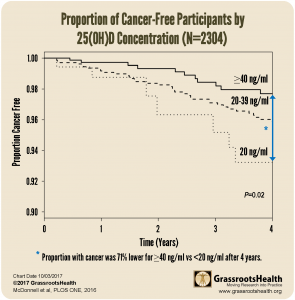 Using statistical analysis, we found that women with vitamin D serum levels greater than or equal to 40 ng/ml had a 71% lower risk of cancer than women with serum levels less than 20 ng/ml. In the graph below you can see that the greatest decrease in risk occurred between about 10 – 40 ng/ml. Calcium did not have any significant effect on cancer risk in this analysis.
Using statistical analysis, we found that women with vitamin D serum levels greater than or equal to 40 ng/ml had a 71% lower risk of cancer than women with serum levels less than 20 ng/ml. In the graph below you can see that the greatest decrease in risk occurred between about 10 – 40 ng/ml. Calcium did not have any significant effect on cancer risk in this analysis.
71% Lower Incidence Cancer with 25(OH)D ≥40 ng/ml
This second look at the combined data uses a Kaplan Meier curve to clearly illustrate the difference between the proportion of cancer-free participants at the end of the 4 year observation period.
Breast Cancer Risk 78-80% Lower with 25(OH)D ≥60 ng/ml
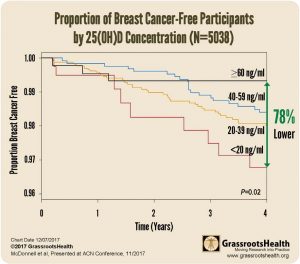 Few studies have assessed the association between 25(OH)D and breast cancer risk in concentrations >40 ng/ml. A 2017 pooled analysis of Lappe’s two RCTs (2007, N=1129 and 2016, N=2196) and the GrassrootsHealth Cohort (N=1713) aimed to investigate the relationship between 25(OH)D and breast cancer risk across a broad range of 25(OH)D concentrations among women aged ≥55 years. Within the pooled cohort (N=5038), 77 women were diagnosed with breast cancer during the observation periods (median follow-up time: 4.0 years) with an age-adjusted incidence of 512 cases per 100,000 person-years. Cox regression showed that women with 25(OH)D concentrations ≥60 ng/ml had an 80% lower risk of breast cancer than women with concentrations <20 ng/ml, adjusted for age, BMI, smoking status and calcium supplement intake (HR=0.20, P=0.02). This information as presented at the American College of Nutrition Symposium, 2017.
Few studies have assessed the association between 25(OH)D and breast cancer risk in concentrations >40 ng/ml. A 2017 pooled analysis of Lappe’s two RCTs (2007, N=1129 and 2016, N=2196) and the GrassrootsHealth Cohort (N=1713) aimed to investigate the relationship between 25(OH)D and breast cancer risk across a broad range of 25(OH)D concentrations among women aged ≥55 years. Within the pooled cohort (N=5038), 77 women were diagnosed with breast cancer during the observation periods (median follow-up time: 4.0 years) with an age-adjusted incidence of 512 cases per 100,000 person-years. Cox regression showed that women with 25(OH)D concentrations ≥60 ng/ml had an 80% lower risk of breast cancer than women with concentrations <20 ng/ml, adjusted for age, BMI, smoking status and calcium supplement intake (HR=0.20, P=0.02). This information as presented at the American College of Nutrition Symposium, 2017.
Take Action Today and Measure Your Levels of the Above – While Contributing to Vitamin D & Breast Cancer Research!
Based on the findings presented above, measuring your levels of vitamin D, magnesium, selenium, and omega-3s may help determine if more of these nutrients might be needed to provide the greatest risk reduction for breast cancer and improve outcomes in the case of a breast cancer diagnosis.
Create your custom home blood spot kit with the following measurements to help determine if you are getting enough of the following nutrients shown to benefit your current or future breast health:
- Vitamin D
- Omega-3 Index
- Magnesium PLUS Elements
- Add hsCRP as a marker of inflammation
Having and maintaining healthy vitamin D levels and other nutrient levels can help improve your health now and for the future. Enroll and test your levels today, learn what steps to take to improve your status of vitamin D (see below) and other nutrients and blood markers, and take action! By enrolling in the GrassrootsHealth projects, you are not only contributing valuable information to everyone, you are also gaining knowledge about how you could improve your own health through measuring and tracking your nutrient status, and educating yourself on how to improve it.






